Estimated reading time 12 minutes, 55 seconds.
The two Bell CH-146 Griffon helicopters appeared first, alternating in high and low sweeps over a clearing as they scouted for enemy activity and gathered information about the casualties below. On the ground, four Dutch soldiers lay wounded, some with severe injuries. The Griffons had spotted a silver technical vehicle on a road some distance from the potential landing zone, but no enemy near the cluster of soldiers. Unable to move to a casualty collection point, they had taken cover and popped smoke.
Moments later, a Boeing CH-147F Chinook emerged over the treeline — avoiding the threat of the technical — and descended rapidly, orienting its rear door toward the wounded. As soon as its wheels touched down, a force protection team and medical personnel exited the ramp. The soldiers established covering arcs facing the treeline, while the medics began triage of the injured.
Seconds into their tasks, gunfire erupted from members of a local militia, the South Atropian People’s Army (SAPA), hidden among the trees. The Chinook immediately lifted off to circle away from the fight, while the force protection detail engaged in a brief firefight — eventually killing the small enemy force.

Using stretchers, the medics and soldiers then transported the injured to the returning Chinook, as a Griffon established a protective hover nearby. The medical team, with the assistance of the soldiers, secured and stabilized the patients on the cabin floor. Once airborne, they went to work treating injuries that included a lower jawbone shot off; they communicated vital signs and other critical information with hand signals and notes on a grease pad as the Chinook flew to a medical facility.
“That played out exactly as I wanted it to from a scenario development point of view,” said LCol Richard Harris, the exercise director and head of training for 1 Wing Kingston at the time. Harris is now the commanding officer of 450 Tactical Helicopter Squadron in Petawawa, Ontario.
Why one medic did not immediately begin treating a casualty or why a force protection member did not adopt the right arc was not his primary concern; exercise controllers and observers-coaches-trainers (OCTs) would assess how well tactics, techniques, and procedures were followed.
Harris’s focus was the bigger picture. “Contact happened almost exactly as I wanted, almost down to the second,” he said. “There were some minor things, but people reacted as they should.”
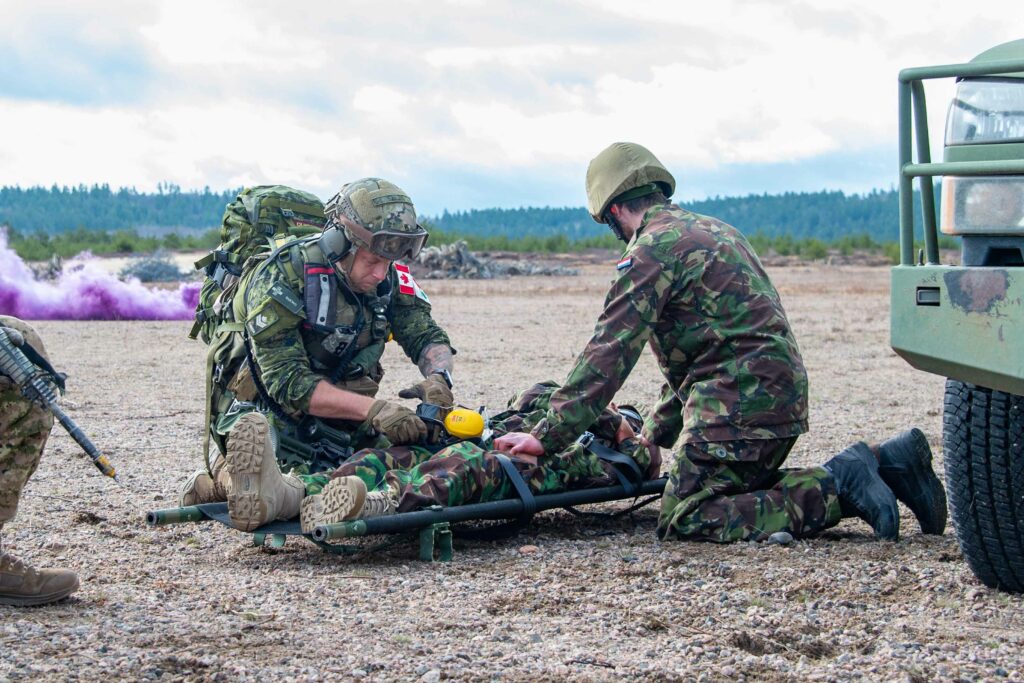
Validating CMERT
The dynamic scenario was part of a validation exercise for the Canadian Medical Emergency Response Team (CMERT), held in late April 2022 at the Petawawa training area. It took place at the end of a two-week course for the medical and force protection personnel, who worked alongside aircrews from 450 Squadron and 438 Tactical Helicopter Squadron.
Forward aeromedical evacuation was a capability developed and deployed to support the United Nations peacekeeping mission in Mali between August 2018 and September 2019.
The Canadian Armed Forces (CAF) had stood up basic aeromedical evac in 2007 for the Griffons, as part of an air task force in Afghanistan. However, larger and better-equipped allied helicopters were often the preferred platforms for the role.
Following a directive from the chief of the defense staff in 2017 to create a scalable capability, the Royal Canadian Air Force (RCAF), the Canadian Army, and the Canadian Forces Health Services Group collaborated to research, trial, and train medical evacuations in conflict zones. The CMERT capability was validated in the late spring of 2018.

Though CMERT can be scaled as required, the primary team consists of 13 personnel: five Chinook crew, including a pilot, co-pilot, two door gunners, and a loadmaster; a medical component of a flight surgeon or trauma doctor, critical care nursing officer, and two aeromedical technicians; and a force protection detail of four infantry soldiers who also provide medical assistance on the ground and in the aircraft.
In most threat environments, the Chinook operates in tandem with a pair of escorting Griffons.
For the UN mission in Mali, the CAF deployed an aviation detachment of about 250 personnel, three Chinooks, and five Griffons to provide troop and cargo transport, as well as medevac. In the latter role, the team conducted 11 medical flights involving over 40 patients, often under difficult conditions. The success highlighted the value of CH-147F and CH-146 aircrews and maintainers working as a single team, as well as the remarkable skill of the soldiers and medical personnel in the back of the Chinook.
Casualty evacuation was always one of several capabilities to be developed when the RCAF first took possession of a new fleet of 15 Boeing-built Chinooks in 2013. So, it was no surprise when direction came down to make CMERT “an enduring capability.”
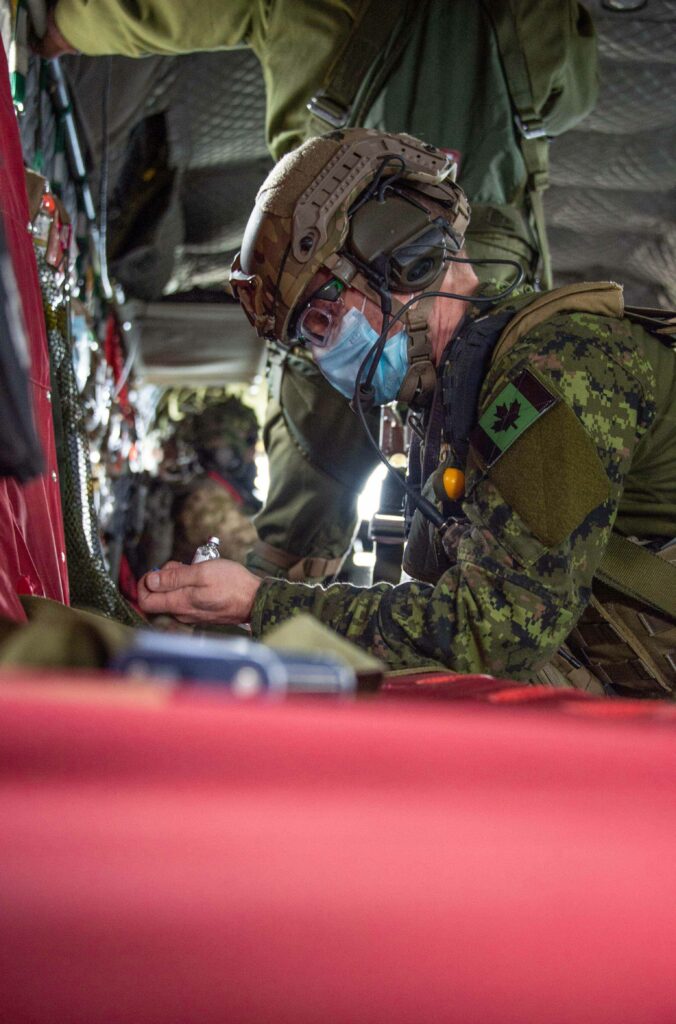
The responsibility for the “overarching CMERT capability integration” falls to 1 Wing; specific kit and specialist medical equipment remain the purview of the operational squadrons and the Health Services Group. The basic training plan is delivered by 426 Transport Training Squadron at 8 Wing Trenton, Ontario. The Army has tasked the 3rd Battalion, The Royal Canadian Regiment (3 RCR) with providing the force protection capability.
To deploy a full CMERT capability into any theater, the aspiration is for four teams to sustain a 24-hour response.
“For us to maintain this enduring capability year in and year out, we need 15 medical specialists,” observed Harris. To train that, he would like to run two basic CMERT courses each year.
Current shortages among medical personnel and pilots make that a difficult proposition. Flight surgeons, for example, are Reservists who hold civilian positions in hospital emergency rooms. They can only deploy for up to three months and have limited capacity to commit to training exercises.
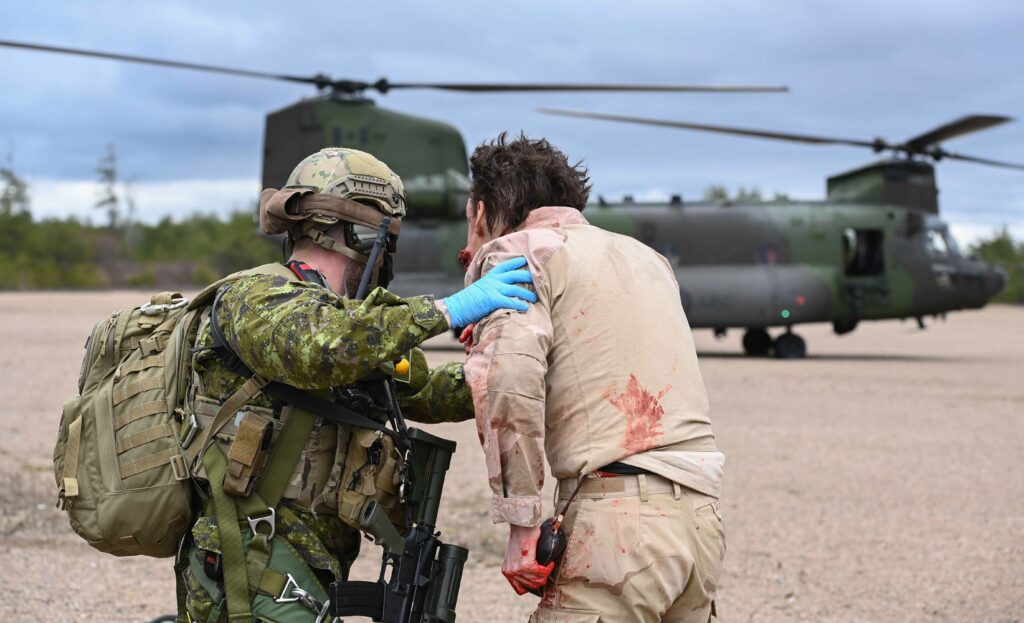
With just 15 Chinooks, 450 Squadron also faces a challenge providing enough helicopters.
“We are struggling from an experiential point of view with relatively junior aircraft captains,” said Harris, who assumed command of the squadron this summer. “We have to focus on force generation because we are the only Chinook squadron in the RCAF,” and there is a growing demand from both the Army and Canadian Special Operations Forces Command to train with the airframe.
1 Wing was able to validate four teams during Striking Bat, a month-long exercise in November 2021 with the United States Marine Corps at the Air Ground Combat Center in Twentynine Palms, California. The capstone exercise featured almost the entire tactical aviation battalion of 300 personnel, including three Chinooks and six Griffon helicopters. But the more realistic number at present is probably three teams, Harris acknowledged.
For the April 2022 course that culminated in the validation of three medical and force protection teams, the Wing ran it at the conclusion of its Basic Tactical Aviation Course (BTAC) — a training event hosted twice a year by 438 Tactical Helicopter Squadron of Saint-Hubert, Quebec, in the Petawawa training area. That allowed the CMERT aircrews, medical personnel, and 3 RCR soldiers to use the existing tents and other infrastructure. It also meant the Griffons, not normally part of CMERT, were already on location.

Harris would like to see future courses run in parallel with BTAC, so “we have the right number of personnel involved. We are trying to set it up so that the BTAC template and the CMERT template are both based out of Petawawa. [Because] the Chinook is such a scarce asset, it is difficult to be able to commit all this capability to various exercises in various locations when it means the aircraft is going to be away from its main operating base for a protracted time.”
Something to think about
The experience in Mali brought home “lots of ways we could potentially do things better,” from inter-aircraft tactics, techniques and procedures (TTP), to the best use of the Chinook cabin and how to store equipment and strap down casualties. Those lessons have informed the CMERT course. But “even on the courses and validation exercises, we are finding ways to tweak how we do what we do in order to continuously improve the capability,” noted Harris. “I have seen some great improvements in what we have done since we went to Twentynine Palms.”
The validation exercise scenario was adapted from the CAF’s Decisive Action Training Environment architecture, but heavily informed by the mission in Mali. Though many elements were simulated, the scenario was realistic and the injuries were gruesomely detailed — thanks to makeup and prosthetics developed by Allied Container Systems.
The aim is to give the medical and force protection team “medical emergencies to really think about,” said Harris.
Because there were fewer Chinook and Griffon aircrews, each one went through the scenarios twice. “They all got to operate with different people in each scenario, and we changed the air mission commanders so it was not the same guy doing the same stuff twice,” explained Harris.
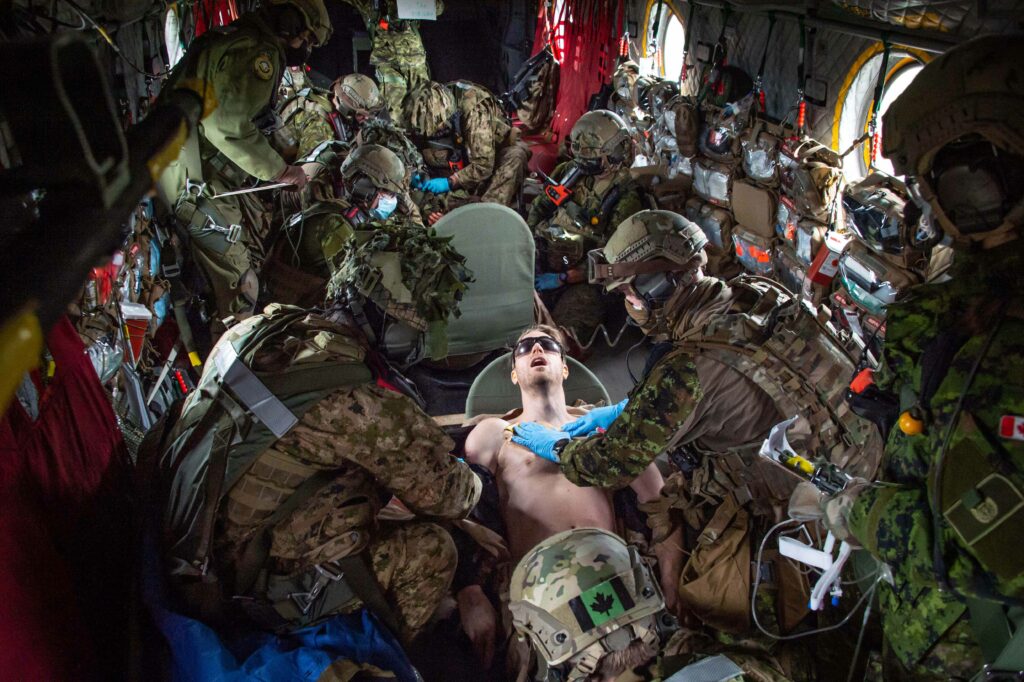
On the ground, the location of the technical vehicle and the direction of the SAPA attack were also changed.
“This is probably my highest-level exposure to all these actors,” said Capt Scott Plantz, a CH-147F pilot, after his second flight. “It’s all experience we can take away because we never know when we are going to be doing it [for real].”
Chinook crews strive to be airborne within 30 minutes of a call to “respect that golden hour” for treating a medical emergency, and they operate the aircraft much like an air ambulance once casualties are onboard. Plantz’s crew was flying within 17 minutes.
“We are trying to create a stable platform where [the medical team] can do their work; not be too aggressive on the controls unless, of course, the threat dictates; and then at that point it is about saving the aircraft and those onboard,” he said.
Unlike BTAC, the CMERT course has a night flying component, requiring pilots to do mixed formation flying in a dynamic scenario. The threat level is “throttled back a bit” to ensure the entire team follows standard operating procedures and their TTPs.
“This will be the first time the medical and force protection guys have operated at night,” noted Harris. “We suggest there is a threat out there, but that threat won’t engage. The guys will find it difficult enough working on NVGs (night vision goggles), working with blacklight torches, and assessing the casualties in the dark. On the final night, we ramp it up a little more and provide an element of fire power that the Griffons will probably have to neutralize.”
Several allies, including the British, took note of the CMERT capability deployed to Mali. Many continue to observe as the CAF fine-tunes how best to validate it on a regular basis.
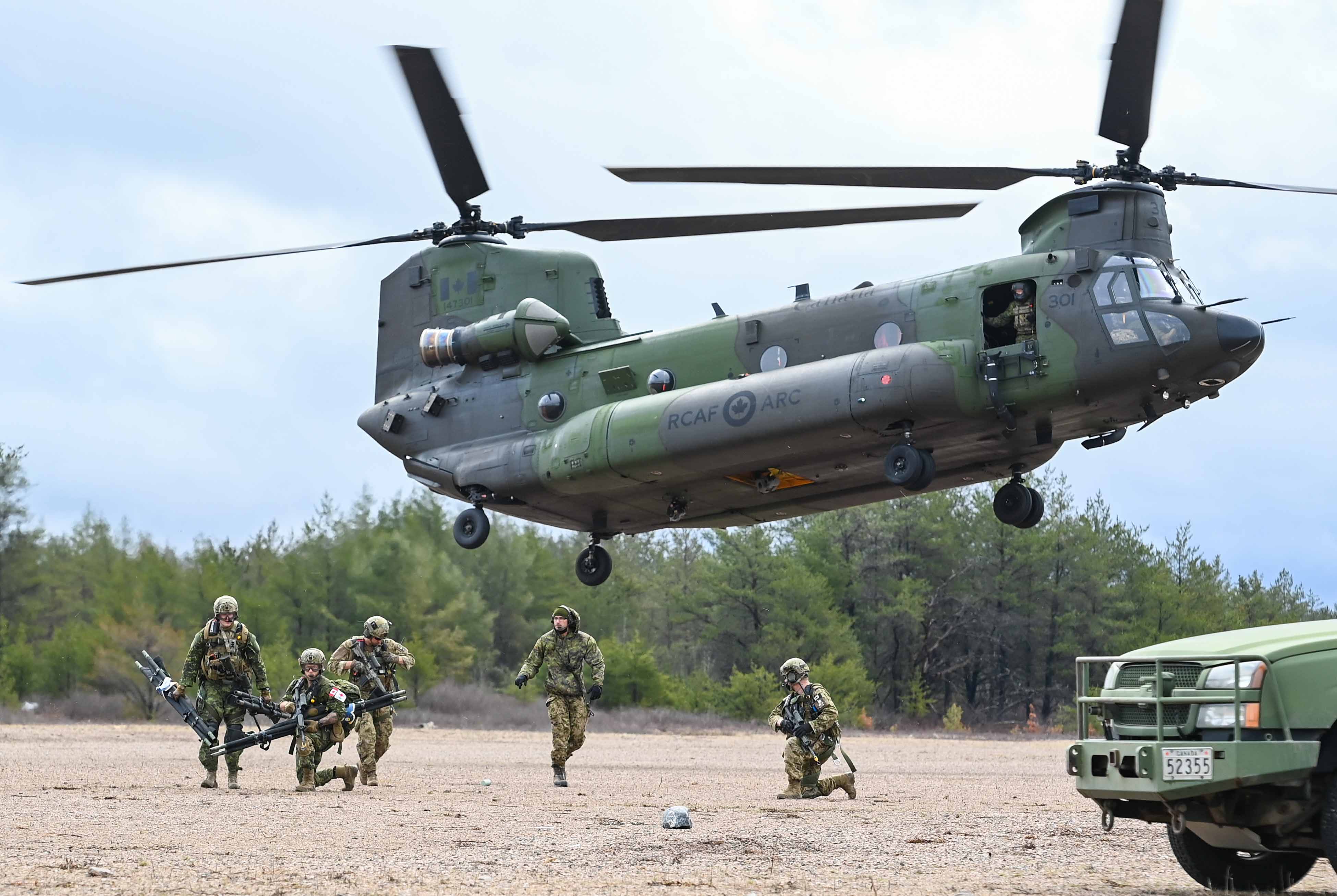

Excellent article which explains how our fighting forces operate in different scenarios. One of the things that kept jumping out at me was the references to the lack of equipment that was mentioned. Even with a personal shortage which I have to believe our government is striving to rectify it seems prudent to consider adding to the Chinook fleet. I’m not sure what the magic number would be if they were to increase the airframe numbers but it seems prudent to start considering this with how long it takes Canada to procure equipment for our military. Just some food for thought.
Thank you. I’m a third generation vet. I’ve served wirh 442Sqn; as a Medic on call. I served with Desert Storm. I served with many ; different circumstances; doing Air Medivac. From air Medivac; from Masset to Prince Rupert. From LAHR Germany to Canada. It’s so important to have the ever changing support: there for our troops.